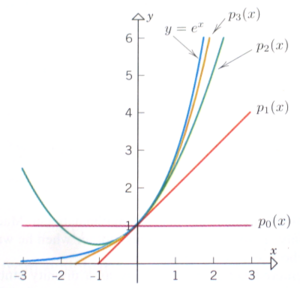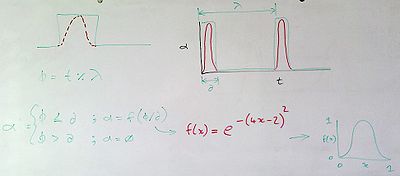e
| A page for e, i, π, and φ |

The role that the exponential function (ex) plays is extremely significant to an understanding of the laws of nature and harmonic organisation. Mathematically (ex) can be expressed several ways. A common form is the Maclaurin series expansion of;
[math]e^x = \sum_{n = 0}^{\infty} {x^n \over n!} = 1 + x + {x^2 \over 2!} + {x^3 \over 3!} + {x^4 \over 4!} + \cdots[/math]
Note that;
[math]e^1 = \sum_{n=0}^{\infty}{1^n \over n!} = 1 + 1 + {1^2 \over 2!} + {1^3 \over 3!} + {1^4 \over 4!} + \cdots[/math]
and
[math]\frac{1}{e} = \sum_{n=0}^{\infty} (-1)^n\frac{1}{n!} = 1-\frac{1}{1!}+\frac{1}{2!}-\frac{1}{3!}+\cdots[/math]
where
[math] e^2 = e^{(1+1)} = e^1 \times e^1 [/math].
or
[math] \sum_{n=0}^{\infty}{2^n \over n!} = \sum_{n=0}^{\infty}{1^n \over n!} \times \sum_{m=0}^{\infty}{1^m \over m!}[/math].
Expansion of the right hand side terms is an outer product, taking the summation of these terms equals e2.
As an infinite sum ex is;
[math]e^x = \sum_{n = 0}^{\infty} {x^n \over n!} = 1 + x + {x^2 \over 2!} + {x^3 \over 3!} + {x^4 \over 4!} + \cdots[/math]
We can look at the construction of this relation more easily by describing it by an algorithm. We can remove the power and factorial operations by basing the current numerator and denominator values on the previous values:
# Returns e^x from e( x, iterations )
sub e {
$x = shift;
$e = $top = $bot = 1;
for $n ( 1 .. shift ) {
$top = $top * $x;
$bot = $bot * $n;
$e = $e + $top / $bot;
}
return $e;
}But a better conceptual representation is to restructure it such that the division occurs outside the main loop since its also a higher-level operation. So each iteration is now maintaining the value of a numerator and denominator which represent the entire preceeding series as a single fraction which can be reduced afterwards.
# Returns e^x from e( x, iterations )
sub e {
$x = $y = shift;
$top = $bot = 1;
for $n ( 1 .. shift ) {
$y = $y + $x;
$top = $top * $n + $y;
$bot = $bot * $n;
}
return $top / $bot;
}Here's a snipit in C which uses the taylor series of cosine to make Φ from π
// Calculate Phi from pi
double Phi = 0;
int n, i = -1;
for (n = 0; n < iterations; n += 2) {
Phi += pow(PI/5,n) / factorial(n) * (i = -i);
}
Phi *= 2;The unit circle
The nth roots of unity, or de Moivre numbers, are all the complex numbers which yield 1 when raised to a given power n. It can be shown that they are located on the unit circle of the complex plane and that in that plane they form the vertices of a n-sided regular polygon with one vertex on 1.
Factorial & the Gamma Function
The Gamma function extends the factorial function to complex and non-integer numbers (it is already defined on the naturals, and has simple poles at the negative integers). The Gamma function "fills in" the factorial function for non-integer and complex values of n. If z is a real variable, then for natural number values only, we have
[math]\Gamma(z+1)= z \times \Gamma(z) = z!\, [/math]
but for non-natural values of z, the above equation does not apply, since the factorial function is not defined.
If the real part of the complex number z is positive, then the following integral converges absolutely:
[math]\Gamma(z) = \int_0^\infty t^{z-1} e^{-t}\,dt[/math]
An interesting property is the Gamma functions link to π;
[math] \Gamma(\frac{1}{2}) = \sqrt\pi [/math]
Taylor series expansion
Taylor's theorem expresses a function f(x) as a power series in x, basically because the nth derivative of xn is n!.
- Why is it that when we reduce the function down to degree-1 through differentiation it ends up as n!? --Nad 17:16, 26 Oct 2006 (NZDT)
Actually, the Taylor series article explains it - the theorem in general for a function f(a) is,
[math]\sum_{n=0}^{\infty} \frac{f^{(n)}(a)}{n!} (x-a)^{n}\,,[/math]
where f (n)(a) denotes the nth derivative of f at the point a; the zeroth derivative of f is defined to be f itself and [math](x-a)^0[/math] is defined to be 1. But all the derivatives are the still ex for the exponential function, and we're using a=0, so the top term here is always equal to 1, leaving only xn on the top. --Nad 18:22, 12 July 2007 (NZST)
Spheres
The volume of an n-dimensional hypersphere can be expressed as:
[math]V_n={\pi^{n/2}R^n\over (n/2)!}.[/math]
Note that the Gamma function is required for odd dimensions and that its value cancels out the apparent fractional power of π in those cases.
Gaussian Function
[math]f(x) = a e^{- { \frac{(x-b)^2 }{ 2 c^2} } }[/math]
for some real constants a, b, c > 0
Pi
- w:Bailey-Borwein-Plouffe formula - provides a spigot algorithm for the computation of the nth binary digit of pi (symbol: π) using base 16 math.








